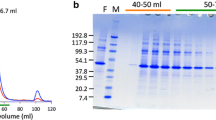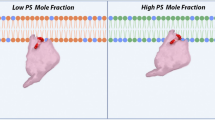Abstract
Interaction of various ligands with recombinant proteins of 5 human FABP types was studied by radiochemical and fluorescence procedures. Liver, heart, intestinal and myelin FABP showed a higher affinity for oleic acid than adipocyte FABP. Intestinal and adipocyte FABP had a relatively high Kd value for arachidonic acid. Liver and intestinal FABP showed high affinity for DAUDA in contrast to the other FABP types. ANS was only well bound by liver and adipocyte FABP. Retinol was not bound by any FABP type, retinoic acid only by adipocyte FABP. Data indicate the importance of both electrostatic and hydrophobic interaction for the ligand-FABP binding. The immunological crossreactivity between six human FABP types including epidermal FABP and their respective antibodies raised in rabbit, chicken and mouse appeared to be low and may suggest heterogeneity of protein surface.
Similar content being viewed by others
References
Veerkamp JH, Maatman RGHJ: Cytoplasmic fatty acid-binding proteins: Their structure and genes. Prog Lipid Res 34: 17–52, 1995
Bennett E, Stenvers KL, Lund PK, Popko B: Cloning and characterization of a cDNA encoding a novel fatty acid binding protein from rat brain. J Neurochem 63: 1616–1624, 1994
Oko R, Morales CR: A novel testicular protein, with sequence similarities to a family of lipid binding proteins, is a major component of the rat sperm perinuclear theca. Dev Biol 166: 235–245, 1994
Owada Y, Yoshimoto T, Kondo H: Spatio-temporally differential expression of genes for three members of fatty acid binding proteins in developing and mature rat brains. J Chem Neuroanat 12: 113–122, 1996.
Iseki S, Kanda T, Hitomi M, Ono T: Ontogenic appearance of three fatty acid binding proteins in the rat stomach. Anat Rec 229: 51–60, 1991
Iseki S, Amano O, Fujii H, Kanda T, Ono T: Immunohistochemical localization of two types of fatty acid-binding proteins in rat ovaries during postnatal development and in immature rat ovaries treated with gonadotropins. Anat Rec 241: 235–243, 1995
Banaszak L, Winter N, Xu Z, Bernlohr DA, Cowan S, Jones TA: Lipid-binding proteins: A family of fatty acid and retinoid transport proteins. Adv Protein Chem 45: 89–151, 1994
Thompson J, Winter N, Terway D, Bratt J, Banaszak L: The crystal structure of the liver fatty acid-binding protein. A complex with two bound oleates. J Biol Chem 272: 7140–7150, 1997
Paulussen RJA, Veerkamp JH: Intracellular fatty acid-binding proteins, characteristics and function. In: H.J. Hilderson (ed). Subcellular Biochemistry, Vol 16. Plenum Press, New York, 1990, pp 175–226
Rolf B, Oudenampsen-Krüger E, Börchers T, Faergeman NJ, Knudsen J, Lezius A, Spener F: Analysis of the ligand binding properties of recombinant bovine liver-type fatty acid binding protein. Biochim Biophys Acta 1259: 245–253, 1995
Glatz JFC, Van der Vusse GJ: Cellular fatty acid-binding proteins: Their function and physiological significance. Prog Lipid Res 35: 243–282, 1996
Richieri GV, Ogata RT, Kleinfeld AM: Equilibrium constants for the binding of fatty acids with fatty acid-binding proteins from adipocyte, intestine, heart, and liver measured with the fluorescent probe ADIFAB. J Biol Chem 269: 23918–23930, 1994
Maatman RGHJ, Van Moerkerk HTB, Nooren IMA, Van Zoelen EJJ, Veerkamp JH: Expression of human liver fatty acid-binding protein in Escherichia coli and comparative analysis of its binding characteristics with muscle fatty acid-binding protein. Biochim Biophys Acta 1214: 1–10, 1994
Wilkinson TCI, Wilton DC: Studies on fatty acid-binding proteins. The detection and quantification of the protein from rat liver by using a fluorescent fatty acid analogue. Biochem J 238: 419–424, 1986
Peeters RA, In 't Groen MAPM, De Moel MP, Van Moerkerk HTB, Veerkamp JH: The binding affinity of fatty acid-binding proteins from human, pig and rat liver for different fluorescent fatty acids and other ligands. Int J Biochem 21: 407–418, 1989
Kane CD, Bernlohr DA: A simple assay for intracellular lipid-binding proteins using displacement of 1–anilinonaphthalene 8–sulfonic acid. Anal Biochem. 233: 197–204, 1996
Peeters RA, Ena JM, Veerkamp JH: Expression in Escherichia coli and characterization of the fatty-acid-binding protein from human muscle. Biochem J 278: 361–364, 1991
Glatz JFC, Baerwaldt CCF, Veerkamp JH, Kempen WM: Diurnal variation of cytosolic fatty acid-binding protein content and of palmitate oxidation in rat liver and heart. J Biol Chem 259: 4295–4300, 1984
Paulussen RJA, Van Moerkerk HTB, Veerkamp JH: Immunochemical quantitation of fatty acid-binding proteins. Tissue distribution of liver and heart FABP types in human and porcine tissues. Int J Biochem 22: 393–398, 1990
Paulussen RJA, Van der Logt CPE, Veerkamp M: Characterization and binding properties of fatty acid-binding proteins from human, pig, and rat heart. Arch Biochem Biophys 264: 533–545, 1988
Uyemura K, Yoshimura K, Suzuki M, Kitamura K: Lipid binding activities of the P2 protein in peripheral nerve myelin. Neurochem Res 9: 1509–1514, 1984
Xu LZ Sanchez R, Sali A, Heintz N: Ligand specificity of brain lipid-binding protein. J Biol Chem 271: 24711–24719, 1996
Takikawa H, Kaplowitz N: Binding of bile acids, oleic acid, and organic anions by rat and human hepatic Z protein. Arch Biochem Biophys 251: 385–392, 1986
Kirk WR, Kurian E, Prendergast FG: Characterization of the sources of protein ligand affinity: 1–sulfonato-8–(1′)anilinonaphthalene binding to intestinal fatty acid binding protein. Biophys J 70: 69–83, 1996
Okuno M, Kato M, Moriwaki H, Kanai M, Muto Y: Purification and partial characterization of cellular retinoic acid-binding protein from human placenta. Biochim Biophys Acta 923: 116–124, 1987
Malpeli G, Stoppini M, Zapponi MC, Folli C, Berni R: Interactions with retinol and retinoids of bovine cellular retinol-binding protein. Eur J Biochem 229: 486–493, 1995
Jakoby MG, Miller KR, Toner JJ, Bauman A, Cheng L, Li E, Cistola DP: Ligand-protein electrostatic interactions govern the specificity of retinol-and fatty acid-binding proteins. Biochemistry 32: 872–878, 1993
Matarese V, Bernlohr DA: Purification of murine adipocyte lipidbinding protein. Characterization as a fatty acid-and retinoic acidbinding protein. J Biol Chem 263: 14544–14551, 1988
Baxa CA, Sha RS, Buelt MK, Smith AJ, Matarese V, Chinander LL, Boundy KL, Bernlohr DA: Human adipocyte lipid-binding protein: purification of the protein and cloning of its complementary DNA. Biochemistry 28: 8683–8690, 1989
Storch J: Diversity of fatty acid-binding protein structure and function: Studies with fluorescent ligands. Mol Cell Biochem 123: 45–53, 1993
Storch J, Herr FM, Hsu KT, Kim HK, Liou HL, Smith ER: The role of membranes and intracellular binding proteins in cytoplasmic transport of hydrophobic molecules: Fatty acid-binding proteins. Comp Biochem Physiol 115B: 333–339, 1996
Hsu K-T, Storch J: Fatty acid transfer from liver and intestinal fatty acid-binding proteins to membranes occurs by different mechanisms. J Biol Chem 271: 13317–13323, 1996
Herr FM, Matarese V, Bernlohr DA, Storch J: Surface lysine residues modulate the collisional transfer of fatty acid from adipocyte fatty acid binding protein to membranes. Biochemistry 34: 11840–11845, 1995
Herr FM, Aronson J, Storch J: Role of portal region lysine residues in electrostatic interactions between heart fatty acid binding protein and phospholipid membranes. Biochemistry 35: 1296–1303, 1996
Author information
Authors and Affiliations
Rights and permissions
About this article
Cite this article
Veerkamp, J., van Moerkerk, H., Prinsen, C. et al. Structural and functional studies on different human FABP types. Mol Cell Biochem 192, 137–142 (1999). https://doi.org/10.1023/A:1006866119264
Issue Date:
DOI: https://doi.org/10.1023/A:1006866119264




